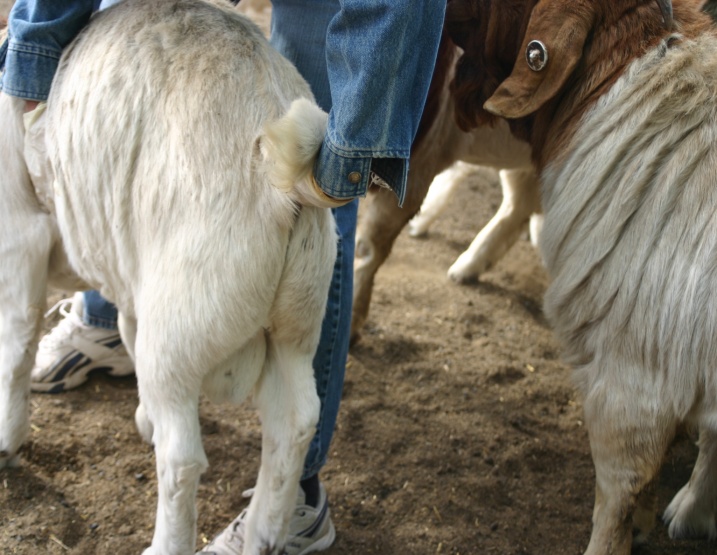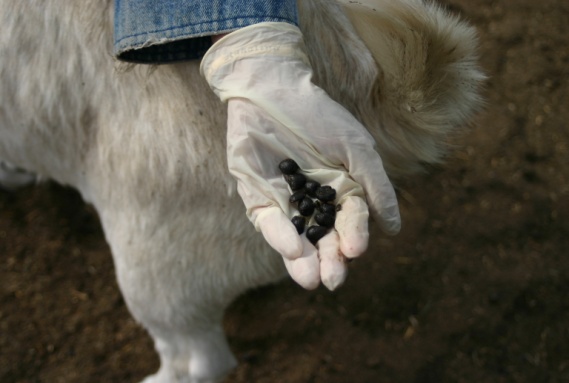NAHMS-460 NAHMS Goat 2019 Enteric Pathogen Collection Record
National Animal Health Monitoring System; Goat 2019 Study
NAHMS 460 JUN 2019
Goat 2019 Study - Respondents
OMB: 0579-0354
National
Animal Health Monitoring System 2150
Centre Ave, Bldg B Fort
Collins, CO 80526 Form
Approved OMB
Number 0579-0354 Expires:



Animal and
Plant Health
Inspection
Service
Veterinary Services
NAHMS Goat 2019
Enteric Pathogen
Collection Record
Kit contents:
50 small Whirl-Pak® bags, 25 medium Whirl-Pak® bags, lubricant, 2 ice packs, 1 liner bag, 1 medium insulated cooler, and paperwork that includes submission form, labels, and 1 UPS airbill addressed to NCSU in Raleigh, NC. You will need to provide your own gloves. Clean gloves are needed for each animal.
Collection Instructions
Collect fecal samples Sunday-Wednesday. Collect fecal samples from 5 goats from each of the following goat types: pregnant does, nursing does, preweaned kids, weaned kids, and open does. If one goat type is not present on the operation, collect extra samples from the highest priority goat type, to up to 10 goats. The sample priority order is pregnant does, nursing does, preweaned kids, weaned kids, and open does.
Fresh
samples are a must. Collect from the rectum
or immediately off the ground while samples are still
warm. Rectal retrieval might not be possible on some goats (e.g.
preweaned kids).
Collect AT LEAST 6 fecal pellets from each animal (plus at least 4 additional pellets for a second bag). Place 6 fecal pellets in one small Whirl-Pak® bag and any remaining fecal pellets (at least 4) in a second small Whirl-Pak® bag. On the labels provided, write the goat’s name or ID and attach the labels onto to the bags.
Express air from Whirl-Pak® bags, twist down twice, and secure.
Place the 2 small Whirl-Pak® bags from each animal in a medium Whirl-Pak® bag and secure. Place all samples in 1 liner bag. Cool down samples with ice packs. Keep cool and, if necessary, replace ice packs with frozen ones before shipping.
RECTAL RETRIEVAL To avoid contamination from common organisms on the ground, rectal retrieval is best. Rectal retrieval might not be possible on some goats (e.g. preweaned kids), and fresh off the ground samples are acceptable. |
|||
|
1. Apply lubricating jelly to the glove before entering the rectum.
|
|
2. Collect duplicate samples:
|
3. On each label, write the goat’s name or ID and attach them on to the small Whirl-Pak® bags. Place the small duplicate bags inside the medium Whirl-Pak® bag. 4. Continue collecting samples from other goats using a clean glove for each animal. |
|||

Collection Form Instructions
Using a BallPoint Pen, record samples on the appropriate lines and complete all information requested.
Send the white and yellow copies to the lab. The pink copy stays with the Producer.
Shipping Instructions
Ship on Monday-Wednesday. Keep samples cool and ship within 24 hours of collection. Wednesday collections must be shipped the same day. Do not collect or ship samples Thursday through Saturday.
Place all the samples in the liner bag and tie shut. Place an ice pack on the top and bottom of the samples. Add filler to box if necessary. Close the insulated cooler box and place the white and yellow collection record on top of the cooler box lid. Leave the pink copy with the Producer.
Secure the box and ship to NCSU in Raleigh, North Carolina, within 24 hours. Ship only Monday-Wednesday.
NOTE: Remove or black out all extraneous labels on outside of box.
NAHMS ID
6 digits |
Primary collector:
Name and phone number |
Date:
mm/dd/yy) |
Kit # on labels: |
1. Sample # |
2. Goat name or ID |
3. Age
(months
|
4. Goat Type
1= pregnant doe 2=nursing doe 3=preweaned kid 4=weaned kid 5=open doe |
5. IF goat type =1 or 2, provide date kidded or expected date to kid
(mm/dd/yy) |
6. Goat housing 1= housed in individual pens 2=housed with other goats of same type (column 4) 3=housed with other goat types (column 4) 4=housed with other livestock (specify livestock) [List all that apply] |
7. Condition(s) in past
1=diarrhea 2=fever 3=respiratory infection 4=thin 5=other (specify) [List all that apply] |
8. Did this animal receive individual
antimicrobial therapy in the last
(Yes/No) [If
No, SKIP |
9. Which individual antibiotic(s) were given in the last 30 days?
|
1 |
|
___ mo OR ___ yr |
|
|
|
|
|
|
2 |
|
___ mo OR ___ yr |
|
|
|
|
|
|
3 |
|
___ mo OR ___ yr |
|
|
|
|
|
|
4 |
|
___ mo OR ___ yr |
|
|
|
|
|
|
5 |
|
___ mo OR ___ yr |
|
|
|
|
|
|
6 |
|
___ mo OR ___ yr |
|
|
|
|
|
|
7 |
|
___ mo OR ___ yr |
|
|
|
|
|
|
8 |
|
___ mo OR ___ yr |
|
|
|
|
|
|
9 |
|
___ mo OR ___ yr |
|
|
|
|
|
|
10 |
|
___ mo OR ___ yr |
|
|
|
|
|
|
1. Sample # |
2. Goat name or ID |
3. Age
(months
|
4. Goat Type
1= pregnant doe 2=nursing doe 3=preweaned kid 4=weaned kid 5=open doe |
5. IF goat type =1 or 2, provide date kidded or expected date to kid.
(mm/dd/yy) |
6. Goat housing 1= housed in individual pens 2=housed with other goats of same type (column 4) 3=housed with other goat types (column 4) 4=housed with other livestock (specify livestock) [list all that apply] |
7. Condition(s) in past
1=diarrhea 2=fever 3=respiratory infection 4=thin 5=other (specify) [list all that apply] |
8. Did this animal receive individual
antimicrobial therapy in the last
(Yes/No) [If
No, SKIP |
9. Which individual antibiotic(s) were given in the last 30 days?
|
11 |
|
___ mo OR ___ yr |
|
|
|
|
|
|
12 |
|
___ mo OR ___ yr |
|
|
|
|
|
|
13 |
|
___ mo OR ___ yr |
|
|
|
|
|
|
14 |
|
___ mo OR ___ yr |
|
|
|
|
|
|
15 |
|
___ mo OR ___ yr |
|
|
|
|
|
|
16 |
|
___ mo OR ___ yr |
|
|
|
|
|
|
17 |
|
___ mo OR ___ yr |
|
|
|
|
|
|
18 |
|
___ mo OR ___ yr |
|
|
|
|
|
|
19 |
|
___ mo OR ___ yr |
|
|
|
|
|
|
20 |
|
___ mo OR ___ yr |
|
|
|
|
|
|
1. Sample # |
2. Goat name or ID |
3. Age
(months
|
4. Goat Type
1= pregnant doe 2=nursing doe 3=preweaned kid 4=weaned kid 5=open doe |
5. IF goat type =1 or 2, provide date kidded or expected date to kid.
(mm/dd/yy) |
6. Goat housing 1= housed in individual pens 2=housed with other goats of same type (column 4) 3=housed with other goat types (column 4) 4=housed with other livestock (specify livestock) [list all that apply] |
7. Condition(s) in past
1=diarrhea 2=fever 3=respiratory infection 4=thin 5=other (specify) [list all that apply] |
8. Did this animal receive individual
antimicrobial therapy in the last
(Yes/No) [If
No, SKIP |
9. Which individual antibiotic(s) were given in the last 30 days?
|
21 |
|
___ mo OR ___ yr |
|
|
|
|
|
|
22 |
|
___ mo OR ___ yr |
|
|
|
|
|
|
23 |
|
___ mo OR ___ yr |
|
|
|
|
|
|
24 |
|
___ mo OR ___ yr |
|
|
|
|
|
|
25 |
|
___ mo OR ___ yr |
|
|
|
|
|
|
Were
samples: 1
stored overnight OR 2
shipped the same day as collected?
How many people in each category helped with the collection of the individual fecal samples?
_____ Fed VMO _____ Fed AHT _____ State government _____ Producer _____ Other, specify:
Total sample time ________ hours
| File Type | application/vnd.openxmlformats-officedocument.wordprocessingml.document |
| File Title | enteric pathogen |
| Author | APHIS:USDA |
| File Modified | 0000-00-00 |
| File Created | 2021-01-15 |
© 2026 OMB.report | Privacy Policy

